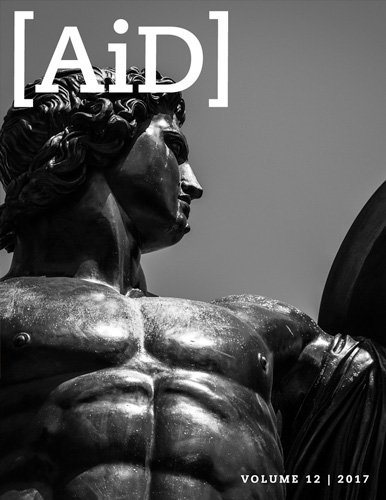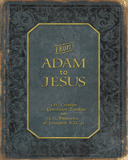
Depicting the Crucifixion of Jesus Christ
Abstract
Portraying well-known scenes from the life of Jesus Christ at the Creation Museum required much research and careful attention to detail. The artists studied an array of topics from the first century AD, including clothing styles, weaponry, and architecture. To develop content for the exhibit, a careful examination was made of relevant biblical passages, archaeology, and linguistics. The result is a stunning new exhibit at the Creation Museum depicting the life, ministry, and salvific work of Jesus Christ from a fresh perspective.
At-a-Glance
- The new Christ, Cross, and Consummation exhibit recently opened at the Creation Museum.
- Fifteen spectacular pieces of art give visitors a fresh look at the life of Christ.
- Three artists blended their styles to give each piece a unique style.
- Research was conducted in a variety of disciplines, from ancient clothing, weaponry, and architecture to archaeology, linguistics, and biblical exegesis.
- The most important message in history is presented in this easy-to-understand, beautiful, and Christ-honoring exhibit.
The new Christ, Cross, and Consummation exhibit opened on Memorial Day weekend at the Creation Museum as the attraction celebrated its 10-year anniversary. The museum takes visitors on a tour through the Seven Cs of History (Creation, Corruption, Catastrophe, Confusion, Christ, Cross, Consummation). Until recently, the final three Cs were covered by The Last Adam film. Now, in addition to the film, guests have an opportunity to walk through an exhibit dedicated to the three final Cs in the list.
Featuring unique and stunning artwork to portray various scenes in the life and ministry of Jesus Christ, the Christ, Cross, and Consummation exhibit is an extraordinary addition to the Creation Museum. One guest recently reported that his daughter committed her life to the Lord as they walked through the exhibit.

Because several questions have been raised about how the artists depicted certain events, particularly the Crucifixion scene, this article will address many of those concerns, describe some of the research that went into each piece, and explain how our artists combined their styles to develop the art pieces.
Artistic Approach
Three artists from the Attractions Division of Answers in Genesis were given the task of illustrating the following 15 scenes for the exhibit:
- The nativity
- Angelic announcement to the shepherds
- Jesus walking on water
- Jesus healing a blind man
- Jesus raising Lazarus
- Jesus casting demons into swine
- The Crucifixion of Jesus
- The burial of Jesus
- The Resurrection of Jesus
- Jesus appearing to Thomas
- The ascension of Jesus
- John’s vision of the Lake of Fire
- John’s vision of the New Jerusalem
- The first Adam
- The last Adam
One of the artists’ goals was to give visitors a fresh look at these famous events. To accomplish this, they sought to portray well-known scenes from a different angle or perspective. They also researched clothing styles, weapons, architecture, languages, and more to create art that accurately reflected what things looked like in first-century Israel.
Another way to accomplish their goal was to share the workload for each piece by blending their styles. The three artists took turns working on each art piece. For example, Ben worked on the Crucifixion scene one day. On the next day, Travis worked on that same piece, before handing it over the Greg to work on the next day. This blending of artistic styles gives each illustration a style all its own.
In this Facebook Live broadcast, Ken Ham talks with the artists about this new exhibit.
The archaeological findings were consulted throughout, but perhaps this is seen most prominently in the three largest pieces: Jesus raising Lazarus, the Crucifixion, and the Resurrection.
Choosing a Stone
Illustrations of the empty tomb belonging to Joseph of Arimathea and the tomb from which Lazarus emerged often show a large disk-shaped stone rolled to the side to reveal the door. While these types of stones have been found in Israel, they represent a very small percentage of the sepulcher-sealing stones that have been discovered—less than one percent.1 These disk-shaped stones were apparently used for royalty or the very wealthy. Most of the stones used to seal tombs were rectangular and functioned sort of like a cork. They were rolled or moved into position in front of the tomb and then pushed into the opening to seal it.
Based on this information, our team had to decide how to depict these scenes. We decided to use the rectangular-shaped stone for the tomb of Lazarus and the disk-shaped stone for the tomb from which Jesus rose. We discussed using the common style for both tombs, but putting a rectangular stone beside the tomb of Jesus would probably be too jarring for many visitors who are accustomed to seeing the disk-shaped stone at the empty tomb. Also, such a drastic change would require explanation, and we did not want to spend too much space in the exhibit describing these types of details while the focus is on the key events. Ultimately, we cannot be sure which style of stone was used to seal Jesus in the tomb, but the language in the Gospels about the stone being “rolled back” (Matthew 28:2) or “rolled away” (Mark 16:4) is perfectly consistent with a disk-shaped stone. Furthermore, since Joseph of Arimathea was a wealthy man (Matthew 27:57), it is certainly possible that Christ’s sepulcher-sealing stone matched those used by wealthy individuals.
Spikes and “Washers”
Traditionally, images of the Crucifixion show three spikes holding Jesus to the Cross—one spike for each hand or wrist and one driven through both feet into the front of the upright post. The Bible does not specify how many nails were used to crucify Jesus. According to historical reports, the Romans did not have a uniform method of crucifying people. Some victims were tied to their crosses while others were nailed.
Historical records from around the time of Christ mention tens of thousands of people being crucified by the Romans. It is somewhat surprising that, as far as we know, we have only found the remains of one crucifixion victim, a man given the name Jehohanan (also spelled as Yehohanan). His remains, along with the remains of a young child, were found in 1968 in an ossuary bearing that name. An ossuary is a bone box commonly used by wealthy families in Israel during the first century AD.
The heel bone had a 4.5-inch spike driven through it (see below). Between the heel bone and the head of the nail, there still remains some wood thought to have been part of a wooden “washer” that would have prevented the victim from pulling himself off the spike. The wood has been identified as coming from either an acacia or pistacia tree. On the opposite end of the spike, traces of olive wood have been discovered. Apparently, the spike was driven into the olive wood and bent upon striking a knot. This is why the Crucifixion painting shows each spike with a wooden “washer.”
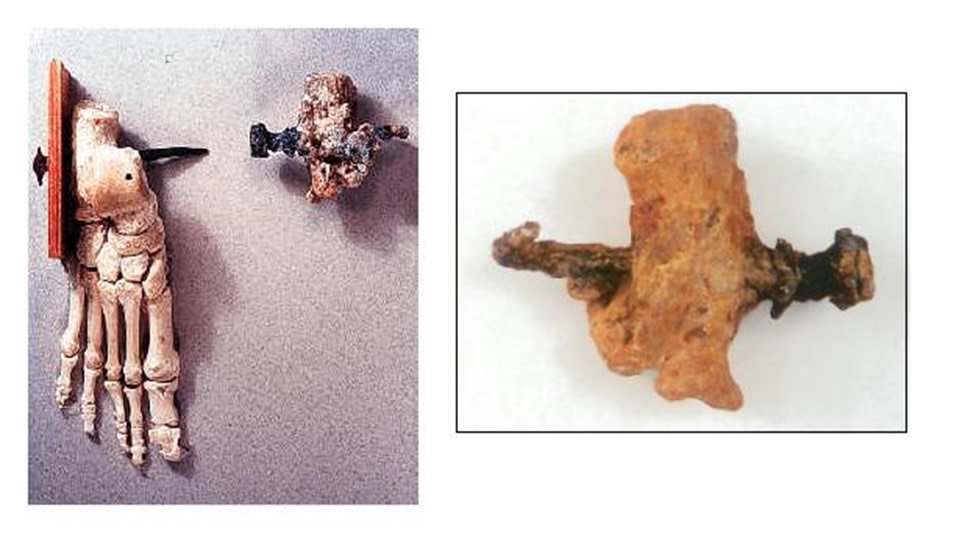
Here is a reconstruction (left) based on the remains (right). The fact that a crucifixion victim’s remains were buried in an ossuary contradicts skeptical claims that crucified individuals could not have received honorable burials.
We cannot know with certainty if these “washers” were used when Jesus was crucified, but if they were, it would be consistent with the scant archaeological evidence we have.
This discovery also led to another difference between our painting and traditional portrayals of the Crucifixion. As mentioned earlier, most illustrations have one spike driven through both of Christ’s feet and into the front of the upright beam of the Cross. If Jesus was crucified in a manner similar to Jehohanan, Christ’s feet would have straddled the upright beam—one spike driven through the left heel would secure the left foot to the Cross and one through the right heel would have nailed his right foot to the Cross.
An objection to this portrayal is that John 19:36 cites Psalm 34:20 as one of the many prophecies fulfilled during Christ’s Crucifixion. The psalmist stated, “He keeps all his bones; not one of them is broken.” John’s comment referred to the fact that the soldiers did not break the legs of Jesus because he was already dead. But would a spike through the heel break the heel bone (calcaneus)? Not necessarily. It all depends on the width of the spike and the sharpness of its point, the condition of the bone, and where the nail is driven through the bone.2 Jehohanan’s heel bone does not appear to have been fractured by the blow. A broken bone would likely not support the body, and if it had broken, it seems that those who placed his bones in the ossuary would have removed the spike.

The main issue with depicting the spikes in the heels is whether this constitutes the breaking of the heel bones, and it may be impossible for us to reach a firm conclusion. Certainly, driving a spike into the heel would necessarily displace some of the bone, but does creating a hole in the bone qualify as a break? During my battle with leukemia, I underwent six bone marrow biopsies in my pelvic bone, but I would never say that I broke my pelvis (even though it certainly felt like it for a short while). It may be wise to refrain from trying to force the language to be overly technical about what constitutes the breaking of a bone since the same objection could be raised against the traditional depiction of the spike driven through the front of the foot. That is, the relatively thin metatarsal bones could easily be chipped or fractured if struck with the spike. Even if they survived the initial blows that pinned the feet to the cross, the constant rubbing of bone on metal would likely chip away some of the bone.
The Alexamenos graffito may be the earliest known pictorial representation of Christ’s Crucifixion. The piece of graffiti cannot be confidently dated, but it is usually placed sometime in the late first century through the late third century. The illustration was apparently intended to mock a Christian man named Alexamenos, who is shown worshipping a crucified man with a donkey’s head. The Greek inscription scoffs at Alexamenos for worshipping a crucified man. The use of the donkey’s head simply adds to the insult.3 Relevant to our discussion is the fact that the engraving shows the man’s feet straddling the upright beam of the cross, although given the crudity of the graffiti we should refrain from drawing any definite conclusions about how crucifixions were carried out.
While we cannot be certain of the exact manner in which Jesus was nailed to the Cross, our depiction of the event is consistent with the biblical account and the scant archaeological evidence.
The Sign on the Cross
Those condemned to death in the Roman Empire often had a placard hung around their neck as they were led to the site of their execution. The Bible does not explain whether Jesus bore a placard on the way to the Cross, but all four Gospels state that one was placed over His head on the Cross. John’s Gospel provides the most detail.
Pilate also wrote an inscription and put it on the cross. It read, “Jesus of Nazareth, the King of the Jews.” Many of the Jews read this inscription, for the place where Jesus was crucified was near the city, and it was written in Aramaic, in Latin, and in Greek. So the chief priests of the Jews said to Pilate, “Do not write, ‘The King of the Jews,’ but rather, ‘This man said, I am the King of the Jews.’” Pilate answered, “What I have written I have written.” (John 19:19–22)
Our team had to do research in an effort to make the sign on the Cross match the biblical description. I contacted experts in ancient languages to make sure our wording in Greek, Aramaic (or Hebrew), and Latin was accurate. Our artists studied documents and inscriptions in each of these languages from around the time of Christ to see how the letters were typically written.
There is some debate about the languages appearing on the sign. Some English Bibles, such as the ESV (above) and the NIV, translate the Greek word as Aramaic instead of Hebrew. Luke 23:38 clearly states the sign was written in Greek, Latin, and Hebrew, but John 19:20 has an adverbial form (Hebraisti), which can be translated as either Hebrew or Aramaic. After examining all five words identified as Hebraisti in the Gospel of John, Ellingworth stated, “Generally, therefore, Hebraisti is understood to refer to Aramaic, where the setting is the daily life of Palestine in the time of Jesus. The inscription over the cross, being a kind of official document, may have been written in Hebrew.”4 Luke’s Gospel uses a word that undoubtedly means Hebrew. This has led some to conclude that four languages appeared on the sign (Hebrew, Aramaic, Latin, and Greek).5
We also had to decide the order in which to present the languages on the sign. The Bible mentions Aramaic (or Hebrew) first, then Latin, and then Greek. Since Latin was the language of the army and government and Greek was the official language of the empire, it seems like these languages would have appeared first and second on the sign. Under normal circumstances, it would be unnecessary to include another language on the sign. But in this case, Pilate clearly wanted to irritate the Jewish leaders, so he made sure the sign included their language and identified Jesus as the King of the Jews, a move that greatly upset them.
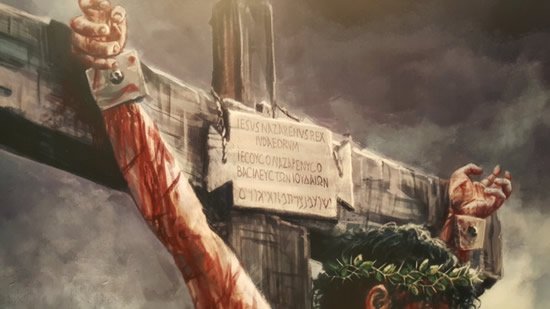
Since Jesus was crucified with two criminals and since it was common practice to use a placard to announce their crimes, we decided to make one for the crucified thief to the right of Jesus in the image. The Bible does not name either thief, so we came up with a name and place of origin for this man and included those details with his crimes. And since there does not seem to be a reason for Pilate to use the thieves to irritate the Jewish leadership, we only used Latin and Greek on his sign. If you look closely you’ll see the words for “John of Chorazin, murderer and thief” above this man’s head.
Does the Bible state that the thieves were also murderers? Matthew 27:38 states that these men were thieves, but the Greek word he used, ληστης (lēstēs), was also used of revolutionaries, insurrectionists, and guerrillas.6 John seems to have used the word in such a way when he described Barabbas as a lēstēs. Mark tells us that Barabbas “was chained with his fellow rebels; they had committed murder in the rebellion” (Mark 15:7). It is very possible that the two thieves crucified with Jesus were two of the “fellow rebels” of Barabbas, since Pilate may have planned to crucify Barabbas that day before the crowd chose to free him (Mark 15:11). If they were companions of Barabbas, then here is clear evidence that they were also involved in murder. Furthermore, when Jesus spoke of being the Good Shepherd, he said, “All who came before me are thieves (κλεπται, kleptai) and robbers (λησται, lēstai)” (John 10:8). If lēstēs refers only to a thief, then it would be quite redundant for Jesus to say that those who came before him were thieves and thieves. If lēstēs may also refer to a murderer, then the Lord’s words make perfect sense.
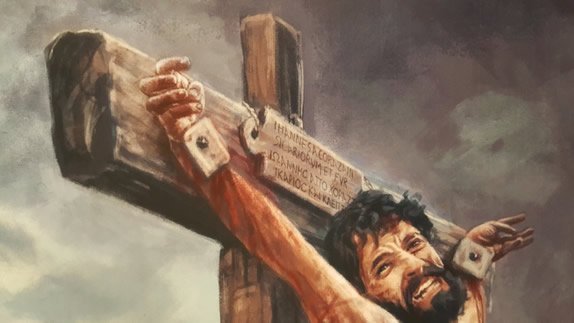
The Crown of Thorns
Most of us have seen images of the crown of thorns pushed into the Lord’s scalp before he was led out to be crucified (Matthew 27:29). Several thorny plants have been suggested as the source of the crown, and, without a specific description in the Bible, we cannot be sure exactly what it looked like. However, our artists did something unique by depicting the crown with green leaves. There were two reasons for this decision. First, it is unlikely the plant used to make the crown would have bent without snapping and breaking if the material had already been dried out, as is often shown in illustrations. So the green leaves were added to show the freshness of the plant.
There is another reason the artists designed the crown the way they did. In our day, when we think of a crown, we tend to think of a gold, jewel-encrusted headgear for royalty. While that same concept existed in ancient times, there was another type of crown popular in the first century AD. The mention of a crown in first century may have evoked images of the wreath awarded to the victor of a sporting contest or to civil servants who made exceptional contributions to society. The Greek word translated as crown in Matthew 27:29 (στεφανον, stephanon) means “a wreath made of foliage or designed to resemble foliage and worn by one of high status or held in high regard, wreath, crown.”7
The Sedile
If you look carefully at the upright beams of the crosses, you will notice a small piece of wood called a sedile fastened to each cross. Several historical sources mention this small “seat” being installed on crosses.8 These uncomfortable additions would permit the victim to obtain a minor degree of relief for their fatiguing arm and chest muscles, thus prolonging their suffering. The Bible does not mention whether the Lord’s Cross had a sedile, but its appearance there is certainly plausible.
Clothing
Many commentators and historians agree that crucifixion victims would have been naked while on the Cross. Stripping the individual was an attempt to increase the shame endured by the condemned person. The fact that the soldiers at the Cross gambled for Christ’s clothes can be seen as evidence that Jesus was hung in such a manner. For obvious reasons, this is one area where we deliberately departed from historical data.
Summary
The Christ, Cross, and Consummation exhibit at the Creation Museum is a superb addition to this world-class facility. The beautiful design, stunning artwork, and its focus on the most important person and message of all time (Jesus Christ and the gospel) make this exhibit a must see. As this article has demonstrated, our team of researchers, writers, artists, and designers paid close attention to every detail to ensure that the life-changing gospel message would be carefully explained in an accurate and appealing manner.
If you have not visited the Creation Museum since this new exhibit opened in May, make plans to visit soon. Be sure to also visit the Ark Encounter to discover more about the Bible’s earliest chapters and the message of God’s mercy and grace in the midst of judgment.
Footnotes
- Only four disk-shaped stones have been found among more than 900 Second Temple-period burial caves examined by Amos Kloner. See Megan Sauter, “How Was Jesus’ Tomb Sealed?” Biblical Archaeology, April 6, 2017, http://www.biblicalarchaeology.org/daily/biblical-sites-places/jerusalem/how-was-jesus-tomb-sealed/.
- As further evidence that a heel bone can withstand this type of trauma, surgeons have safely extracted bone marrow from heel bones by inserting an 11-gauge trocar (approximately 3mm in diameter). Monica H. Schweinberger and Thomas S. Roukis, “Percutaneous Autologous Bone Marrow Harvest from the Calcaneus and Proximal Tibia: Surgical Technique,” ResearchGate, September 2007, https://www.researchgate.net/publication/6079623_Percutaneous_Autologous_Bone_Marrow_Harvest_from_the_Calcaneus_and_Proximal_Tibia_Surgical_Technique.
- Harold Bayley, Archaic England: An Essay in Deciphering Prehistory from Megalithic Monuments, Earthworks, Customs, Coins, Place-Names, and Faerie Superstitions (London: Chapman & Hall Ltd., 1920), 392–394.
- Paul Ellingworth, “Hebrew or Aramaic,” The Bible Translator 37, no. 3 (July 1986), 339.
- For example, Matt Slick of CARM.org believes four languages were used. Matt Slick, “What Was Written on the Sign on the Cross?,” CARM, https://carm.org/bible-difficulties/matthew-mark/what-was-written-sign-cross.
- Frederick William Danker, ed., A Greek-English Lexicon of the New Testament and Other Early Christian Literature (Chicago: University of Chicago Press, 2000), 594.
- Ibid., 943.
- For example, in the second century, Justin Martyr and Irenaeus mention the use of sediles in their day.
Recommended Resources

Answers in Genesis is an apologetics ministry, dedicated to helping Christians defend their faith and proclaim the good news of Jesus Christ.
- Customer Service 800.778.3390
- © 2024 Answers in Genesis

